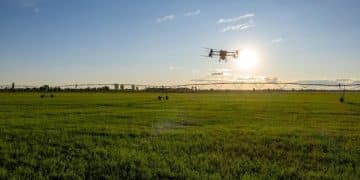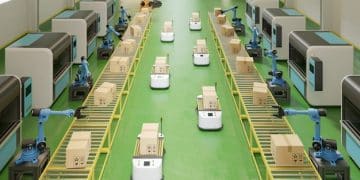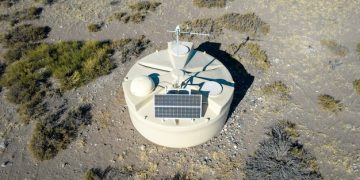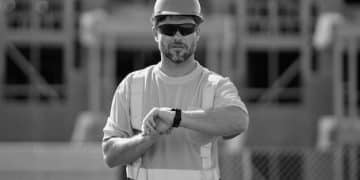Newest US Drone Tech Developments for Commercial Use
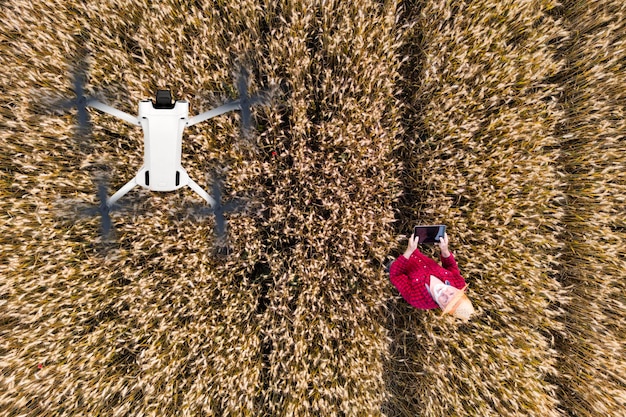
The newest developments in US drone technology for commercial use include advancements in autonomous flight, enhanced battery life, improved sensor technology, and expanded use in industries like agriculture, delivery services, and infrastructure inspection.
The commercial drone industry in the United States is soaring to new heights, driven by cutting-edge technological advancements. Let’s explore the newest developments in US drone technology for commercial use, transforming industries and creating unprecedented opportunities.
Autonomous Flight Capabilities
One of the most significant advancements in US drone technology is the development of increasingly sophisticated autonomous flight capabilities. These technologies allow drones to perform complex tasks with minimal human intervention, enhancing efficiency and safety across various commercial applications.
Advanced Navigation Systems
Modern drones are equipped with advanced navigation systems that utilize GPS, computer vision, and sensor fusion to navigate complex environments. These systems enable drones to avoid obstacles, follow pre-programmed routes, and adapt to changing conditions in real-time.
AI-Powered Flight Control
Artificial intelligence (AI) plays a crucial role in enhancing autonomous flight capabilities. AI algorithms enable drones to make intelligent decisions, optimize flight paths, and perform tasks such as object recognition and tracking.
- Enhanced Precision: AI-powered systems allow drones to execute tasks with greater precision, reducing errors and improving overall performance.
- Real-time Adaptability: Drones can autonomously adjust to unexpected changes in weather, airspace, or mission requirements.
- Reduced Workload: Autonomous features reduce the need for constant human control, allowing operators to manage multiple drones simultaneously.
Autonomous flight capabilities are revolutionizing industries such as agriculture, where drones can autonomously monitor crop health, apply pesticides, and collect valuable data. Similarly, in infrastructure inspection, drones can autonomously inspect bridges, power lines, and other critical assets, identifying potential issues before they escalate.
Enhanced Battery Life
Extending the battery life of commercial drones is a critical area of development, as it directly impacts the range, duration, and efficiency of drone operations. Advancements in battery technology are enabling drones to stay airborne for longer periods, expanding their capabilities and use cases.
Lithium-Ion Innovations
Lithium-ion batteries remain the standard in the drone industry, but ongoing research is focused on increasing their energy density, reducing their weight, and improving their lifespan. Innovations in battery chemistry and manufacturing processes are contributing to these improvements.
Solid-State Batteries
Solid-state batteries represent a promising alternative to traditional lithium-ion batteries. These batteries offer higher energy density, improved safety, and faster charging times. While still in the development phase, solid-state batteries have the potential to significantly extend drone flight times.
- Increased Flight Time: Enhanced battery life allows drones to perform more extensive missions without the need for frequent recharging.
- Expanded Range: Drones can cover larger areas, making them suitable for applications such as long-distance delivery and remote monitoring.
- Improved Efficiency: Longer flight times reduce downtime and increase the overall efficiency of drone operations.
The development of longer-lasting batteries is particularly beneficial for applications such as package delivery, where drones need to travel significant distances. In environmental monitoring, extended flight times enable drones to collect more data over larger areas, providing valuable insights for conservation efforts.
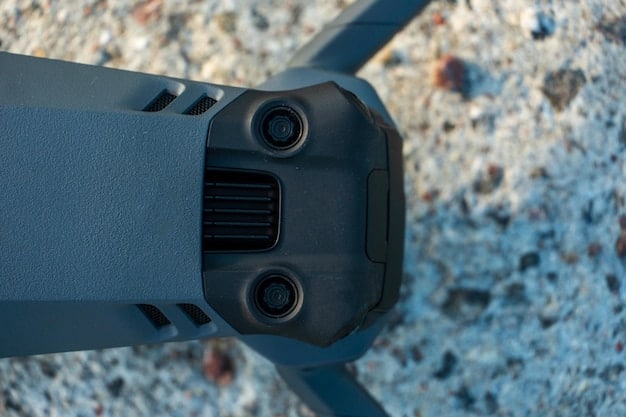
Improved Sensor Technology
Advanced sensor technology is transforming the capabilities of commercial drones, enabling them to capture high-quality data and perform complex analyses. These sensors provide valuable insights across a wide range of industries, from agriculture to construction.
High-Resolution Cameras
High-resolution cameras are essential for capturing detailed imagery and video. Modern drone cameras offer enhanced zoom capabilities, improved low-light performance, and advanced image stabilization, providing clear and accurate data.
LiDAR and Thermal Sensors
LiDAR (Light Detection and Ranging) sensors use laser technology to create detailed 3D models of the environment, while thermal sensors detect heat signatures. These sensors are used in applications such as surveying, mapping, and infrastructure inspection, providing valuable information that is not visible to the naked eye.
- Precise Data Collection: Advanced sensors enable drones to collect highly accurate and detailed data, improving the quality of insights.
- Enhanced Analysis: High-quality data allows for more sophisticated analysis, leading to better decision-making.
- Expanded Applications: Improved sensor technology opens up new possibilities for drone use in various industries.
For example, in the construction industry, drones equipped with LiDAR sensors can create precise 3D models of construction sites, enabling project managers to track progress and identify potential issues. In agriculture, thermal sensors can detect areas of stress in crops, allowing farmers to take targeted action.
Expanded Use in Agriculture
The agricultural sector is one of the fastest-growing markets for commercial drones. Drones equipped with advanced sensors and imaging technology are helping farmers improve crop yields, reduce costs, and manage resources more efficiently.
Crop Monitoring and Analysis
Drones can fly over fields and capture high-resolution imagery, providing farmers with detailed information about crop health, growth rates, and potential problems. This data can be used to identify areas that need attention, such as irrigation issues or pest infestations.
Precision Application of Inputs
Drones can be used to precisely apply fertilizers, pesticides, and herbicides to crops, reducing waste and minimizing environmental impact. This targeted approach ensures that inputs are applied only where they are needed, optimizing resource use.

Data-Driven Decision Making
By collecting and analyzing data from drone flights, farmers can make more informed decisions about planting, irrigation, and pest control. This data-driven approach leads to improved yields, reduced costs, and more sustainable farming practices.
Drones are transforming agriculture by providing farmers with the tools they need to optimize their operations and improve their bottom line. From monitoring crop health to precisely applying inputs, drones are helping farmers achieve greater efficiency and sustainability.
Delivery Services
The use of drones for delivery services is gaining traction in the US, with companies exploring the potential to deliver packages, medications, and other goods quickly and efficiently. Advancements in drone technology are making this vision a reality.
Package Delivery
Drones can deliver packages directly to customers’ doorsteps, bypassing traffic congestion and reducing delivery times. This is particularly valuable in urban areas, where traffic can be a major obstacle.
Medical Supply Delivery
Drones can be used to deliver critical medical supplies, such as medications, blood, and organs, to remote or hard-to-reach areas. This can be life-saving in emergency situations.
Regulatory Challenges
Despite the potential benefits, the widespread adoption of drone delivery services faces regulatory challenges. The FAA (Federal Aviation Administration) is working to develop regulations that ensure the safe and responsible use of drones for delivery purposes. As the regulatory landscape evolves, drone delivery services are expected to become more common.
Drone delivery services have the potential to revolutionize the way goods are transported, offering faster, more efficient, and more cost-effective delivery options. As technology advances and regulations evolve, drones are poised to play a significant role in the future of logistics.
Infrastructure Inspection
Drones are increasingly being used for infrastructure inspection, providing a safe and efficient way to assess the condition of bridges, power lines, pipelines, and other critical assets. Drones equipped with high-resolution cameras and sensors can identify potential problems before they escalate, saving time and money.
Bridge Inspections
Drones can inspect bridges from all angles, capturing detailed imagery of structural components. This allows inspectors to identify cracks, corrosion, and other signs of deterioration.
Power Line Inspections
Drones can fly along power lines, inspecting them for damage, such as broken insulators or sagging wires. This helps utility companies maintain reliable power delivery.
Pipeline Inspections
Drones can patrol pipelines, detecting leaks and other anomalies. This helps prevent environmental damage and ensures the safe transport of oil and gas.
Infrastructure inspection is a critical application for commercial drones, offering a safer, more efficient, and more cost-effective way to maintain our nation’s infrastructure. By identifying potential problems early, drones can help prevent costly repairs and ensure the continued safe operation of critical assets.
| Key Point | Brief Description |
|---|---|
| ✈️ Autonomous Flight | Drones now navigate and perform tasks with minimal human input, enhancing precision and safety. |
| 🔋 Enhanced Battery | Advanced batteries extend drone flight times, enabling broader applications and increased efficiency. |
| 📸 Improved Sensors | High-resolution cameras and LiDAR provide detailed data for diverse industries like agriculture and construction. |
| 📦 Delivery Services | Drones offer fast and efficient delivery of packages and medical supplies, but face regulatory challenges. |
Frequently Asked Questions (FAQ)
▼
Commercial drones in the US are primarily used for agriculture, infrastructure inspection, delivery services, aerial photography, and surveillance. They provide cost-effective and efficient solutions for various industries.
▼
AI enhances drone capabilities by enabling autonomous flight, real-time adaptability, object recognition, and improved decision-making. This leads to greater precision and efficiency in drone operations.
▼
In agriculture, drones offer benefits such as crop monitoring, precision application of inputs, and data-driven decision-making. Farmers can improve yields, reduce costs, and manage resources more efficiently.
▼
The FAA is responsible for regulating the use of drones in the US airspace. They establish rules and guidelines to ensure the safe and responsible operation of drones, including those used for commercial purposes.
▼
Advancements in drone battery technology include lithium-ion innovations and solid-state batteries. These developments aim to increase energy density, reduce weight, improve lifespan, and enhance overall flight times for commercial drones.
Conclusion
The newest developments in US drone technology for commercial use are revolutionizing industries and creating unprecedented opportunities. From autonomous flight capabilities and enhanced battery life to improved sensor technology and expanded applications in agriculture, delivery services, and infrastructure inspection, drones are transforming the way businesses operate and delivering valuable benefits to society.
